SIMPLIFYING RADICAL EXPRESSIONS INVOLVING FRACTIONS WORKSHEET
Use the quotient property to write the following radical expression in simplified form.
|
(1) |
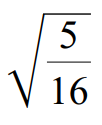 | |
|
(2) |
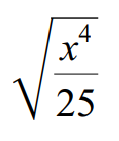 | |
|
(3) |
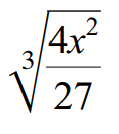 | |
|
(4) |
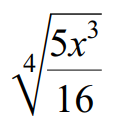 | |
|
(5) |
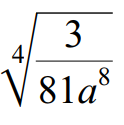 | |
|
(6) |
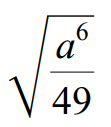 | |
|
(7) |
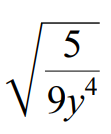 | |
|
(8) |
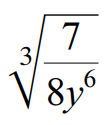 |

Detailed Answer Key
Problem 1 :
Use the quotient property to write the following radical expression in simplified form.

Solution :
√(5/16) = √5 / √16
√(5/16) = √5 / √(4 ⋅ 4)
Index of the given radical is 2.
Because its index is 2, we can take one term out of radical for every two same terms multiplied inside the radical sign.
√(5/16) = √5 / 4
Problem 2 :
Use the quotient property to write the following radical expression in simplified form.

Solution :
√(x4/25) = √x4 / √25
√(x4/25) = √(x2 ⋅ x2) / √(5 ⋅ 5)
Index of the given radical is 2.
Because its index is 2, we can take one term out of radical for every two same terms multiplied inside the radical sign.
√(x4/25) = x2 / 5
Problem 3 :
Use the quotient property to write the following radical expression in simplified form.

Solution :
3√(4x2/27) = 3√4x2 / 3√27
3√(4x2/27) = 3√(4x2) / 3√(3 ⋅ 3 ⋅ 3)
Index of the given radical is 3.
Because its index is 3, we can take one term out of radical for every three same terms multiplied inside the radical sign.
3√(4x2/27) = 3√(4x2) / 3
Problem 4 :
Use the quotient property to write the following radical expression in simplified form.

Solution :
4√(5x3/16) = 4√(5x3) / 4√16
4√(5x3/16) = 4√5x3 / 4√(2 ⋅ 2 ⋅ 2 ⋅ 2)
Index of the given radical is 4.
Because its index is 4, we can take one term out of the radical for every four same terms multiplied inside the radical sign.
4√(5x3/16) = 4√5x3 / 2
Problem 5 :
Use the quotient property to write the following radical expression in simplified form.

Solution :
4√(3/81a8) = 4√3 / 4√(81a8)
4√(3/81a8) = 4√3 / 4√(3a2 ⋅ 3a2 ⋅ 3a2 ⋅ 3a2)
Index of the given radical is 4.
Because its index is 4, we can take one term out of the radical for every four same terms multiplied inside the radical sign.
4√(3/81a8) = 4√3 / 3a2
Problem 6 :
Use the quotient property to write the following radical expression in simplified form.

Solution :
√(a6/49) = √a6/√49
√(a6/49) = √(a3 ⋅ a3)/(7 ⋅ 7)
Index of the given radical is 2.
Because its index is 2, we can take one term out of the radical for every two same terms multiplied inside the radical sign.
√(a6/49) = a3/7
Problem 7 :
Use the quotient property to write the following radical expression in simplified form.

Solution :
√(5/9y4) = √5 / √9y4
√(5/9y4) = √5 / (3y2 ⋅ 3y2)
Index of the given radical is 2.
Because its index is 2, we can take one term out of the radical for every two same terms multiplied inside the radical sign.
√(5/9y4) = √5 / 3y2
Problem 8 :
Use the quotient property to write the following radical expression in simplified form.

Solution :
3√(7/8y6) = 3√7 / 3√(8y6)
3√(7/8y6) = 3√7 / 3√(2y2 ⋅ 2y2 ⋅ 2y2)
Index of the given radical is 3.
Because its index is 3, we can take one term out of the radical for every three same terms multiplied inside the radical sign.
3√(7/8y6) = 3√7 / 2y2
Kindly mail your feedback to v4formath@gmail.com
We always appreciate your feedback.
©All rights reserved. onlinemath4all.com
Recent Articles
-
Digital SAT Math Problems and Solutions (Part - 62)
Nov 05, 24 11:16 AM
Digital SAT Math Problems and Solutions (Part - 62) -
SAT Math Resources (Videos, Concepts, Worksheets and More)
Nov 05, 24 11:15 AM
SAT Math Resources (Videos, Concepts, Worksheets and More) -
Worksheet on Proving Trigonometric Identities
Nov 02, 24 11:58 PM
Worksheet on Proving Trigonometric Identities